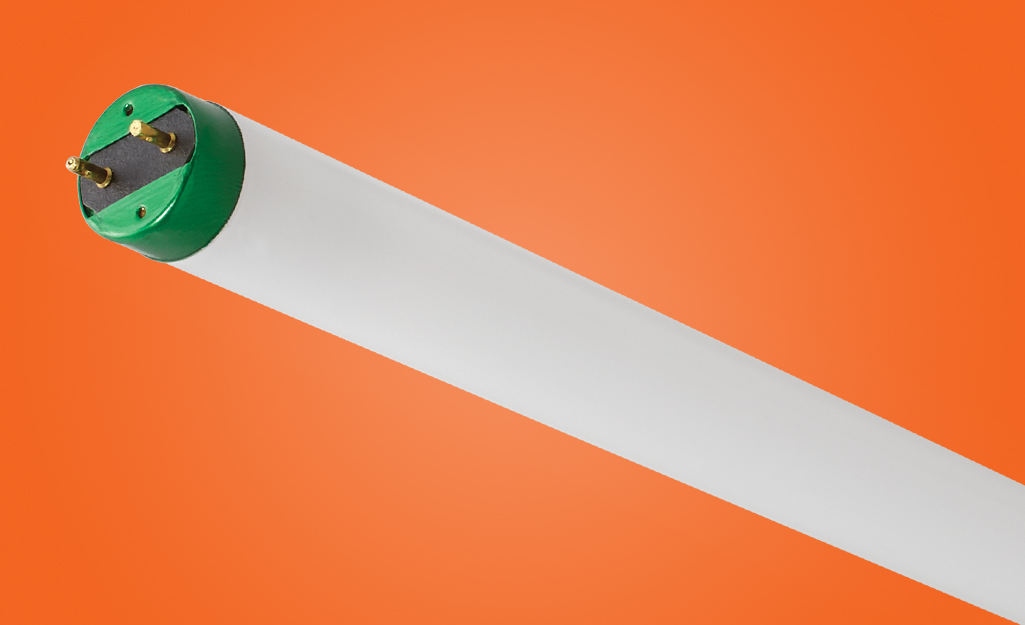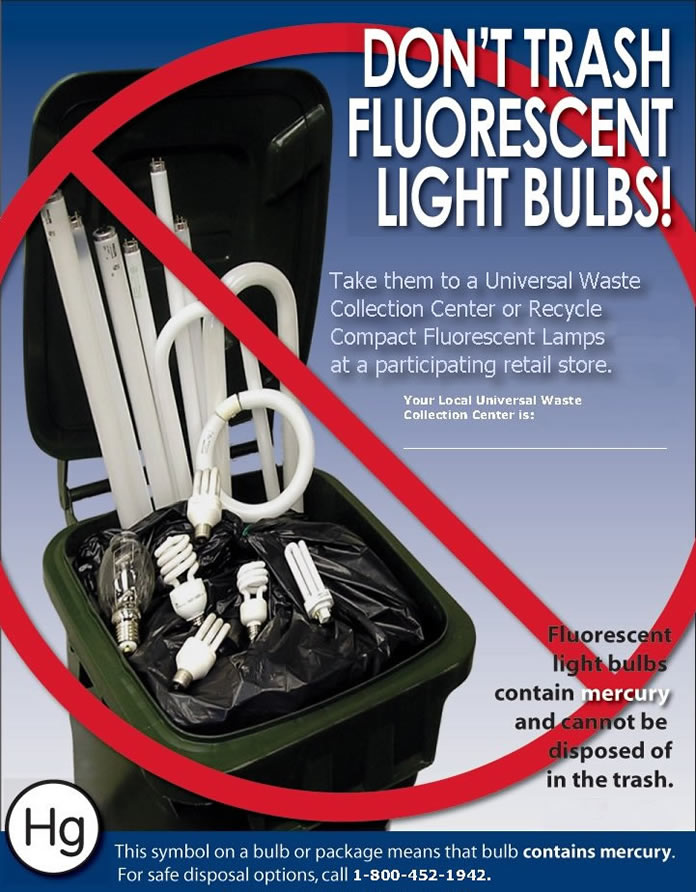Dispose of fluorescent bulbs by taking them to a local recycling center or a hazardous waste collection event. Many retailers also offer recycling programs for these bulbs.
Disposing of fluorescent bulbs safely is crucial due to their mercury content, which can be harmful to both the environment and human health if not handled correctly. Ensure the right disposal of these items by researching local regulations and options for recycle or waste disposal in your area.
Recycling fluorescent bulbs conserves resources and prevents the release of hazardous substances into landfills.
Most communities provide accessible solutions for residents, often through waste management services or dedicated recycling events. Engaging in the correct disposal of fluorescent bulbs is a responsible step toward maintaining a healthy community and a clean environment.
Hazards Of Improper Disposal
Getting rid of fluorescent bulbs the wrong way can harm our planet and health. Let’s shine light on why we must toss them out safely.
Environmental Risks
Fluorescent bulbs contain mercury, a dangerous substance. When bulbs break in landfills, mercury leaks out. This can poison water and harm wildlife.
- Water contamination: Mercury can seep into groundwater.
- Wildlife impact: Animals can ingest mercury, damaging ecosystems.
- Air pollution: If incinerated, mercury releases toxic fumes.
Human Health Concerns
Mercury from bulbs can reach us too. It causes serious health issues if we’re exposed.
- Breathing problems: Inhaling mercury vapor leads to respiratory issues.
- Brain effects: Mercury can affect brain function, especially in kids.
- Skin contact: Touching broken bulbs might cause mercury exposure.
Types Of Fluorescent Bulbs
Different fluorescent bulbs light up our spaces in unique ways. Knowing how to properly dispose of them starts with understanding the different types. Let’s break down the two main varieties.
Compact Fluorescent Lamps (cfls)
Compact Fluorescent Lamps, often known as CFLs, are energy-savers. They fit in most fixtures designed for incandescent bulbs.
- Spiral-shaped or with a tube bent to look like a bulb
- Uses up to 70% less energy than incandescent bulbs
- Lasts up to 10 times longer
Fluorescent Tube Lights
Fluorescent tube lights are long, thin, and usually found in offices and industrial spaces. They come in varying sizes and lengths.
| Size | Common Applications |
|---|---|
| T4 | Under cabinet lighting |
| T5 | Commercial settings |
| T8 | Modern office spaces |
| T12 | Older fixtures |
Fluorescent tubes range from very slim (T4) to the thicker T12s. They all contain a small amount of mercury. That’s why it’s crucial to dispose of them safely.
Safe Disposal Steps
Fluorescent bulbs contain mercury. It is vital to dispose of them correctly. This guide will explain how to do it safely.Preparation and Handling
Preparation And Handling
Never break or crush fluorescent bulbs. This releases harmful mercury. Wear gloves and safety glasses for protection. Work in a well-ventilated area. Always clean your hands after handling the bulbs.Collection and Storage
Collection And Storage
Prepare a storage area for used bulbs. This area should be dry, secure, and away from high traffic. Bulbs should be kept in their original packaging. If not available, use a container that can support their weight and length.Transportation Requirements
Transportation Requirements
Local regulations may dictate transportation needs. Check with local waste management services. Carry fluorescent bulbs upright. Secure them to prevent breakage. Transport them in a vehicle with good ventilation.
Credit: www.co.burlington.nj.us
Recycling Options
Proper disposal of fluorescent bulbs protects the environment. Recycling is key. Learn the top ways to recycle your fluorescent bulbs safely.
Local Recycling Programs
Many communities offer recycling programs. They handle fluorescent bulbs safely. These programs prevent toxins from harming the ecosystem. Check with local waste management for details.
Mail-back Services
Companies offer mail-back services. They send you a container. You fill it with used bulbs. Send them back for proper recycling. This service is convenient and safe.
Retail Drop-off Sites
Some stores accept used fluorescent bulbs for recycling. Known as retail drop-off sites, they make bulb disposal easy and accessible. Find a participating store. Drop off your bulbs next time you shop.
For each option:
- Check availability in your area.
- Gather your bulbs carefully.
- Follow the program guidelines.
Legal Regulations And Compliance
Understanding the legal regulations and compliance for disposing of fluorescent bulbs is vital. Bulbs contain mercury, a substance that can harm the environment. They require careful disposal following federal and state laws. Compliance ensures safety for people and the planet.
Federal And State Guidelines
The Environmental Protection Agency (EPA) has specific guidelines for fluorescent bulb disposal. States may have additional regulations.
- Consult the EPA guidelines for universal waste.
- Check your state’s environmental agency for local requirements.
- Recycle bulbs using certified facilities to ensure compliance.

Credit: www.homedepot.com
Alternatives To Fluorescent Lighting
Disposing of fluorescent bulbs requires care. Seeking alternatives can reduce disposal concerns.
Led Technology
LED lights offer remarkable benefits over fluorescents. They last longer and are more energy-efficient. LEDs use up to 75% less energy and last 25 times longer. Transform spaces while saving money and energy.
- Bright, consistent lighting
- Instant-on with no flickering
- Variety of shapes and sizes available
- No toxic chemicals, such as mercury
Environmental Impact Of Alternatives
Choosing the right lighting affects our planet’s health. LEDs have a smaller carbon footprint. They reduce greenhouse gas emissions due to lower energy consumption. Fewer bulb replacements mean less waste. Consider these alternatives for a greener future.
| Lighting Type | Energy Use | Lifespan | Waste Produced |
|---|---|---|---|
| Fluorescent | Medium | Short to medium | Higher |
| LED | Low | Long | Lower |

Credit: www.maine.gov
FAQs For How To Dispose Of Fluorescent Bulbs
Are Fluorescent Bulbs Hazardous Waste?
Fluorescent bulbs contain mercury, which is a hazardous material. Therefore, they must be disposed of responsibly to avoid environmental contamination. Do not throw them in regular trash.
How Should I Dispose Of Used Fluorescent Tubes?
Contact your local waste management services for proper disposal. Many areas have specific drop-off locations or recycling programs for fluorescent tubes to ensure safe handling of the mercury inside.
Can I Recycle Fluorescent Light Bulbs At Home Depot?
Yes, Home Depot offers a recycling program for compact fluorescent light bulbs (CFLs). Check with your local store for their specific policy, but generally, you can bring in used bulbs for proper disposal.
What Should I Do If A Fluorescent Bulb Breaks?
If a fluorescent bulb breaks, ventilate the area. Carefully collect the pieces, using gloves, and place them in a sealed plastic bag. Refer to the EPA’s guidelines for cleaning up broken fluorescent bulbs safely.
Conclusion
Handling fluorescent bulbs correctly benefits both the environment and your safety. Remember to check local regulations and consider recycling as a responsible disposal method.
A little effort goes a long way – ensuring these bulbs are disposed of properly helps keep hazardous waste out of landfills and supports a healthier planet for all.

